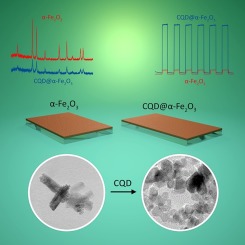Applied Catalysis B: Environment and Energy ( IF 22.1 ) Pub Date : 2018-01-08 , DOI: 10.1016/j.apcatb.2018.01.016 Omran Moradlou , Zeinab Rabiei , Alireza Banazadeh , Juliusz Warzywoda , Mohammad Zirak

|
To improve the photoresponsivity of hematite-based photoanode via better charge transfer rate and short paths for the electron transport, carbon quantum dots (CQDs) were used as conductive nano-scaffolds for the growth of photoactive material on Ti substrate. [email protected]α-Fe2O3 nanoparticulates with the average diameter of 3–5 nm were uniformly grown on the substrate under the finely optimized experimental conditions to prepare Ti/[email protected]α-Fe2O3 photoanode. The photocurrent response of the resulted photoanode with a photocurrent density of 2.1 mA cm−2 at applied Ebias of +0.5 V vs. Ag/AgCl was increased by a factor of 10 compared to Ti/α-Fe2O3, mainly due to the improvement in charge-transfer rate and suppression of electron-hole recombination derived from the increased hole-diffusion length in conducting nano-scaffold structure. The surface morphology of samples was investigated with FE-SEM and HRTEM. Charge transfer resistance (Rct) of Ti/α-Fe2O3 and Ti/[email protected]α-Fe2O3 photoanodes were estimated to be about 90.9 and 3.7 KΩ, respectively. After the continuous 4 h illumination of Ti/[email protected]α-Fe2O3 photoanode under the visible light irradiation, the efficiency of water splitting process (i.e. the photocurrent) did not changed significantly (±5%), indicating the high stability of photoanode and tightly deposited [email protected]α-Fe2O3 on Ti substrate, which was confirmed by FE-SEM image of the sample after the experiment. The formation of carbon-oxygen chemical bonds between CQDs and hematite molecules was confirmed by X-ray photoelectron spectroscopy (XPS). Finally, based on XRD pattern and photoresponses of various photoanodes annealed at different temperatures, the results showed that the structure design is as significant as crystallinity in hematite-based photoelectrodes.
中文翻译:

碳量子点纳米支架为的α-Fe 2 ö 3生长:制备Ti / [电子邮件保护]的α-Fe 2 ö 3光电阳极的水分解可见光照射下
为了通过更好的电荷传输速率和较短的电子传输路径来改善赤铁矿基光阳极的光响应性,碳量子点(CQDs)被用作导电纳米支架,用于在Ti衬底上生长光敏材料。[电子邮件保护]的α-Fe 2个ö 3纳米颗粒具有3-5nm的平均直径均匀地生长在衬底上的精细优化的实验条件下,制备的Ti / [电子邮件保护]的α-Fe 2 ö 3光电阳极。与Ti /α-Fe相比,在施加的+0.5 V的E偏压下相对于Ag / AgCl的光电流密度为2.1 mA cm -2的所得光阳极的光电流响应提高了10倍2 O 3,主要是由于在传导纳米支架结构中空穴传输长度的增加而改善了电荷传输速率并抑制了电子-空穴复合。用FE-SEM和HRTEM研究了样品的表面形态。电荷转移电阻(R CT的Ti /的α-Fe的)2 ö 3和Ti / [电子邮件保护]的α-Fe 2个ö 3光阳极被估计为约90.9和3.7KΩ,分别。的Ti的连续4小时光照后/ [电子邮件保护]的α-Fe 2 ö 3在可见光照射下的光阳极,水裂解过程(即,光电流)的效率并没有显著改变(±5%),这表明光电阳极的高稳定性和紧密地沉积[电子邮件保护]的α-Fe 2 ö 3 Ti基体上,由实验后样品的FE-SEM图像证实。通过X射线光电子能谱(XPS)证实了CQD与赤铁矿分子之间碳-氧化学键的形成。最后,基于X射线衍射图谱和在不同温度下退火的各种光阳极的光响应,结果表明,结构设计与赤铁矿基光电极的结晶度一样重要。


























 京公网安备 11010802027423号
京公网安备 11010802027423号